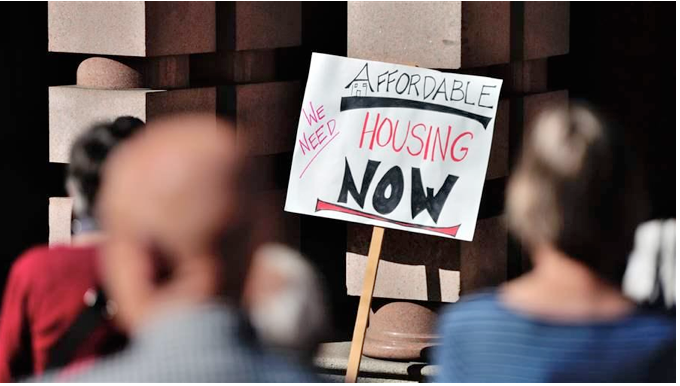CommentsHERE’S WHAT I KNOW-Since 2000, the cost of housing in Los Angeles has outpaced income growth by four times. Conventional financial advice suggests spending no more than a third of a monthly paycheck on rent or mortgage payment but more than half of Southern Californians spend over 30% on housing, leaving many Angelenos cash-strapped for food, healthcare, transportation, and savings.
Just what does this mean in concrete terms? How many teachers or physicians can afford to purchase a home in Southern California? The real estate site Estately has published a pair or infographics to compare average salaries for six occupations with average home prices in eight different markets to establish the percentage of homes affordable for people in each of the professions. Estately pulled average annual salaries from Glassdoor for teachers, astronauts, firefighters, doctors, restaurant servers, and computer programmers in Los Angeles, San Francisco, Seattle, Chicago, Detroit, Philadelphia, and Atlanta to determine how much people could afford to spend on a home. The site took into account not only monthly mortgage payments but also down payment, property taxes, homeowner’s insurance, and other costs.
Estately analyzed home sales in all eight markets for six months to figure the percentage of professionals in each of the six professions who could afford to purchase a home in each market and the results may be surprising.
In the Los Angeles market, doctors are the only profession where over fifty percent could afford the average home price and the percentage came in at just over 75 percent. Forty-two percent of computer programmers can afford home ownership in Southern California and only three percent of teachers can cover the monthly mortgage, along with other expenses.
Housing affordability is even worse in San Francisco, where the median home price is now $1,150,000, leaving teachers, firefighters, restaurant servers, and astronauts priced out of the city. On the other side of the spectrum, Detroit and St. Louis are the most affordable for moderate income homebuyers.
If 97 percent of teachers and 98 percent of firefighters are priced out of the LA market, what will the future hold in the Southern California housing market? A decrease in homeownership means an ever-growing rental market. Following market principles of supply and demand, rents will also continue to increase.
The shortage of affordable housing is a complicated issue. Some say the solution rests in expanding mass transportation, easing commutes to outlying areas with lower home prices. In San Francisco,
The Mayor’s Office of Housing and Community Development’s Teacher Next Door Program was established to help fulltime teachers in the San Francisco Unified School District purchase a first home within the boundaries of the city and county of San Francisco.
The U.S. Housing Department and Urban Development Good Neighbor Next Door Sales Program offers substantial incentives to teachers of pre-kindergarten through 12th grade, firefighters, and emergency medical technicians to purchase homes located in revitalization areas that are listed exclusively through the program. Properties are listed for seven days and buyers receive a fifty percent discount off the list price in return for a commitment to live in the property for 36 months as sole residence.
Finding and implementing solutions to the affordable housing crisis in Los Angeles and other cities requires creative problem solving and cooperation between government agencies, developers, and lenders. Addressing the problem is the first step.
(Beth Cone Kramer is a Los Angeles-based writer and writes for CityWatch.) Prepped for CityWatch by Linda Abrams.















